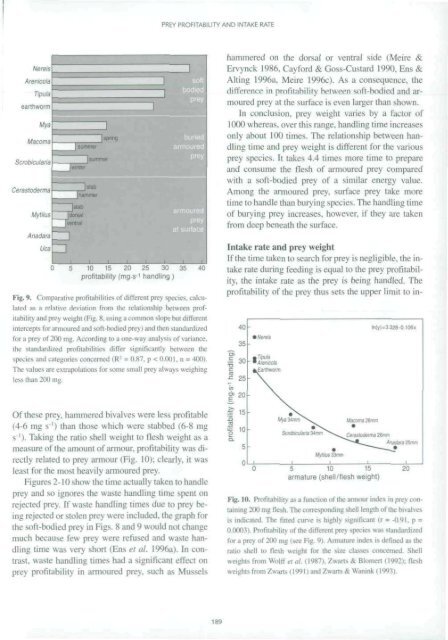waders and their estuarine food supplies - Vlaams Instituut voor de ...
waders and their estuarine food supplies - Vlaams Instituut voor de ...
waders and their estuarine food supplies - Vlaams Instituut voor de ...
You also want an ePaper? Increase the reach of your titles
YUMPU automatically turns print PDFs into web optimized ePapers that Google loves.
Nereis<br />
Arenicola<br />
tipuia<br />
earthwo'm<br />
Mya<br />
Macoma<br />
Scrobicularia<br />
Cerasto<strong>de</strong>rma<br />
Mytilus<br />
Anadara<br />
Uca<br />
PREY PROFITABILITY AND INTAKE RATE<br />
soil<br />
0 5 10 15 20 25 30 35 40<br />
profitability (mgs-' h<strong>and</strong>ling)<br />
Fig. 9. Coinparaiive profitabilities rf diltercni prev species, calcu<br />
lated as a relative <strong>de</strong>viation from the relationship between prof<br />
itability <strong>and</strong> prey weighl (Fig. 8. using a common slope buldilferent<br />
intercepts l"t armoured <strong>and</strong> soft-bodied prey l<strong>and</strong> then st<strong>and</strong>ardized<br />
for a prey of 200 mg. According to a one-wa) analysis ..| variance,<br />
Ihe st<strong>and</strong>ardized proliiahihlies difler signilicanlly between Ihe<br />
species <strong>and</strong> categories concerned (R : = 0.87. p < 0.001. n = 41X1)<br />
The values are extrapolations lor some small prey always weighing<br />
less than 21X1 mg.<br />
Of these prey, hammered bivalves were less profitable<br />
(4-6 mg s ') than those which were stabbed (6-8 mg<br />
Faking the ratio shell weight to llesh weight as a<br />
measure of the amount of armour, profitability was directly<br />
related to prey armour (Fig. 10): clearly, it was<br />
least for the most heavily armoured prey.<br />
Figures 2-10 show ihe lime actually laken to h<strong>and</strong>le<br />
prey <strong>and</strong> so ignores ihc waste h<strong>and</strong>ling time spent on<br />
rejected prey. If waste h<strong>and</strong>ling times due to prey being<br />
rejected or stolen prey were inclu<strong>de</strong>d, the graph for<br />
the soft-bodied prey in Figs. 8 <strong>and</strong> 9 would not change<br />
much because few prey were iel used <strong>and</strong> waste h<strong>and</strong>ling<br />
time was very short (Ens et ul. 1996a). In conirasi.<br />
waste h<strong>and</strong>ling limes had a significant effect on<br />
piev profitability in armoured prey, such as Mussels<br />
189<br />
hammered on the dorsal or ventral si<strong>de</strong> tMeire .V<br />
Ervynck 1986, Cayford & Goss-Custard 1990. Ens &<br />
Ailing 1996a. Meire 1996c). As a consequence, the<br />
difference in profitability between soft-bodied, <strong>and</strong> armoured<br />
prey at the surface is even larger than shown.<br />
In conclusion, prey weight varies by a factOI of<br />
1000 whereas, over this range, h<strong>and</strong>ling time increases<br />
only about 100 times. The relationship between h<strong>and</strong>ling<br />
time <strong>and</strong> prey weight is different for the various<br />
prey species. It takes 4.4 times more time to prepare<br />
<strong>and</strong> consume the flesh of armoured prey compared<br />
with a soft-bodied prey of a similar energy value.<br />
Among the armoured prey, surface prey take more<br />
time to h<strong>and</strong>le than burying species. The h<strong>and</strong>ling time<br />
of burying prey increases, however, if they arc laken<br />
from <strong>de</strong>ep beneath the surface.<br />
Intake rate <strong>and</strong> prey weight<br />
If the time taken lo search for prey is negligible, the iniake<br />
rate during feeding is equal to the prey profitability,<br />
the iniake rale as the prey is being h<strong>and</strong>led. The<br />
profitability of the prey thus sets the upper limit (0 in-<br />
•10<br />
35<br />
• Ne/M<br />
V/.'js *8jm<br />
5 10 15<br />
armature (shell/flesh weight)<br />
rnCyl=3.328-0 I06»<br />
riMiManHianiiiMi<br />
rVadantSa ••<br />
Fig. III. Profitability as a function ol ihe annum in<strong>de</strong>x in prey con<br />
taining 2(H) mg llesh. The corresponding shell length of ihe bivalves<br />
is unhealed The fitted curve is highly significant (r = -0.91, p =<br />
0.00031. Profitability ol the ditleieni pie) Species KM st<strong>and</strong>ardized<br />
for a prey of 2IX) mg (see Fig ll. Armature in<strong>de</strong>x is <strong>de</strong>fined as the<br />
ratio shell to flesh weighl for the size classes concerned Shell<br />
weights from Wolff el al. ' 1987), /"wans & Women | I9°2i. llesh<br />
weights from Zwarts 11991) <strong>and</strong> Zwarts & Wanink (I'W).<br />
20

















